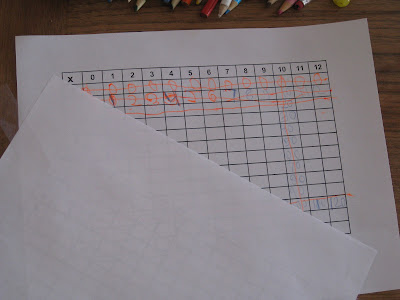In the photos below, our young math student is beginning the process of completing a multiplication fact chart. While this activity, with all of the empty boxes, can appear daunting to a student. There are many ways to break this exercise into manageable "chunks" of learning.
By breaking the process into known and easily completed segments the student is able to develop a sense of confidence and control over his knowledge of the number facts. It is very important that this exercise not be timed. VSLs typically struggle with time management and time awareness. Their struggles to perform are then exacerbated by their difficulty recalling these basic facts. The image below shows the multiplication chart with the first zero written in for the student as part of an introduction to the process of filling in the chart with all of the facts 0 to 12.
This model comes from Alexander Shires Golon's website and her downloadable PDF:
Nothin' But the Facts
In the following two images we can see that the student has begun to enter his facts. Before he began entering the numbers he and I discussed what he already knew about multiplication. In a previous post, this student and I explored and reaffirmed his readiness to begin learning the multiplication facts. This student demonstrated a clear understanding of grouping, the ability to skip count (counting by 2's, 5's, 10's, etc.), and an awareness of doubling.
We then worked together to explore his chart and fill in all of the facts that he was surprised to see that he knew.
 |
| Note the one's facts and the series of 6's. He corrects below. |
 |
| With a new chart, student corrected his error above. |
|
|
|
|
Although there is much we don't yet know about this student, we can view the two images above and learn a great deal about how he learns. In the first image this 2nd grader has begun his chart with enthusiasm. A close look at that first image shows a brief line sketched across the numbers. Even though the student has a chart with small boxes with one for each number, he chose to create another level of control by adding a line before he entered the numbers.
VSLs often struggle with handwriting, letter and number reversals and organization. This student said out loud as he drew the line: "I do this to keep it all together." It was clear in watching him work that writing each number was a thoughtful effort for him. He did not reverse his numbers in this exercise, although that has been a problem for this student.
The first image also displays a series of 6's entered by mistake. This is another clear example of how much a VSL can struggle with a seemingly simple task. The task will take longer for this student, result in more errors, and cause it to appear that he knows less then he does. In helping this student gain mastery over this exercise and in recognizing his prior knowledge of the basic facts, this student is on his way to developing a meaningful understanding of the facts which will transfer into a deeper learning experience and retention.
In an upcoming post, we will watch this student continue to fill out the chart using prior number sense to guide his efforts. We will also learn some tricks!























